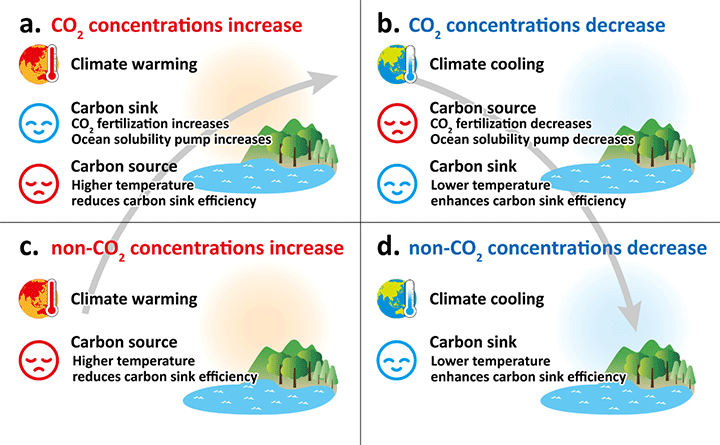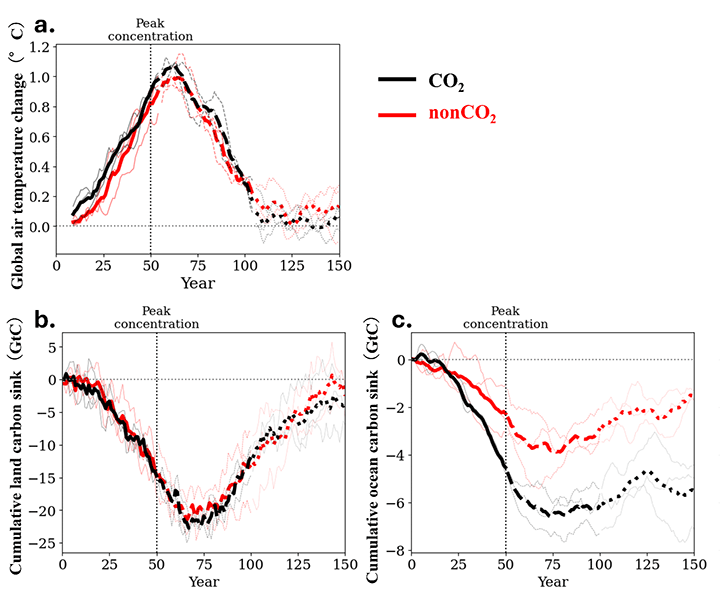最新の研究成果 How can the global carbon cycle respond to CO2 and non-CO2 mitigation?
Our new study explores how reducing non-CO2 greenhouse gases—like methane and nitrous oxide—alongside CO2 reductions can facilitate more effective climate change mitigation. While both CO2 and non-CO2 greenhouse gases drive global warming, they influence “natural” carbon absorption by land and ocean—known as “carbon sinks”—in different ways. This research highlights that targeting both CO2 and non-CO2 gases together can better protect carbon sinks on land and in the oceans for more effective and sustainable climate policy.
The study used advanced Earth system model simulations to explore how carbon dioxide, methane, and nitrous oxide affect global warming and carbon sinks under a set of experiments with both increasing and decreasing concentrations. The carbon sinks act as natural buffers, absorbing and storing CO2, which helps slow the rate of climate change. However, as temperatures rise, the effectiveness of land and ocean carbon sinks decreases, leading to acceleration of global warming.
While both CO2 and non-CO2 greenhouse gases trap heat, they affect natural carbon sinks on land and in the oceans in different ways. CO2 contributes to climate change by trapping heat. But it also enhances the carbon sinks: on land, it boosts plant growth—a process known as "CO2 fertilisation"—and in the oceans, it increases carbon absorption through the "solubility pump". This means that the increase in CO2 concentration has both warming and carbon sink-enhancing effects (Figure 1a). When the CO2 concentration is reduced, both warming and the sink-enhancing effects are diminished: plant growth stimulated by CO₂ fertilisation decreases on land, and the ocean's ability to absorb carbon through the solubility pump weakens (Figure 1b).
Non-CO2 greenhouse gases such as methane and nitrous oxide also trap heat, but obviously these gases do not enhance carbon sinks through fertilisation effect or solubility pump (Figure 1c). When concentrations of these gases are reduced, there is a cooling effect without direct impacts on the ability of the natural environment to absorb atmospheric carbon dioxide through fertilisation or the solubility pump (Figure 1d). This distinction makes reducing concentrations in non-CO2 gases a valuable complement to the CO2 mitigation efforts. Reducing methane concentrations, for example, can immediately lower the rate of warming because methane has a strong but short-lived warming effect. The combined mitigation that addresses both types of gases has the potential to deliver faster and greater cooling than tackling CO2 alone.

At the core of these findings the study introduces an analytical framework that enables better understanding of the different ways greenhouse gases interact with the carbon cycle. The framework identifies three key feedback mechanisms that link the changes in CO2 and non-CO2 greenhouse gases and carbon sinks: (1) the effect of changes in CO2 concentration on carbon sinks through CO2 fertilisation effects and the solubility pump, (2) the effect of temperature changes on carbon sinks, and (3) a “combined effect” (Figure 2). The latter combined effect has the most complex representation, where changes in CO2 concentrations and temperatures interact to influence carbon sinks. However, this combined effect can significantly influence the global carbon sink, especially over the ocean (see Figure 2b and c, where the effects of temperature changes and combined effect on the carbon sink are shown).
The findings underscore the need for multifaceted climate action strategies that combine CO2 and non-CO2 mitigation. This approach enables scientists and policymakers to strengthen natural climate sinks and work toward a more sustainable future.

Melnikova, I., Ciais, P., Tanaka, K., Shiogama, H., Tachiiri, K., Yokohata, T., and Boucher, O.: Carbon cycle and climate feedbacks under CO2 and non-CO2 overshoot pathways, Earth Syst. Dynam., 16, 257–273, https://doi.org/10.5194/esd-16-257-2025, 2025.
